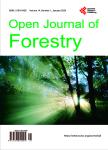Responses of Dobera glabra and Eight Co-Occurring Species to Drought and Salinity Stress at a Savanna-Scrub Ecotone:Implications in the Face of Climate Change
热带稀树草原-灌木交错带中光肩星天牛和八种共生植物对干旱和盐分胁迫的响应:气候变化面临的启示作者机构:World Agroforestry CentreNairobiKenya Georg-August University of GottingenBurckhardt-Institute of Tropical Silviculture and Forest EcologyGottingenGermany Department of Crop Science and ProductionBotswana College of AgricultureGaboroneBotswana
出 版 物:《Open Journal of Forestry》 (林学期刊(英文))
年 卷 期:2014年第4卷第4期
页 面:327-337页
学科分类:1002[医学-临床医学] 100214[医学-肿瘤学] 10[医学]
基 金:financed by the German Academic Exchange Service(DAAD)
主 题:Drought Tolerance Reforestation Domestication Plant Water Relation Adaptation Acacia Woodlands Ethiopia Agroforestry
摘 要:To quantify the resistance of different co-occurring species to drought and osmotic stress (salinity stress), plant water (Ψ) and osmotic (Ψp) potentials were measured during the dry season. We applied a pressure chamber and cryoscopy to measure Ψ and Ψp, respectively. The species revealed a wide range of responses to water stress (-0.83 to -5.8 MPa) and osmotic stress (-1.3 to -3.2 MPa) and not all plants fit closely into one or the other category. Evergreen species tended to have lower Ψ than deciduous species. Notably, Dobera glabra, well known as drought indicator tree in the region, showed the lowest Ψ (up to -5.8 MPa) and Ψp (-3.2 MPa). This indicates its outstanding drought and osmotic stress tolerance and explains its ability to thrive in drought prone areas and years. The recent expansion of A. oerfota and A. mellifera in the study area could be related to their tolerance of osmotic stress, which may imply a trend of soil salinization. The division of plant responses into categories or strategies can be valuable aid to understanding long-term plant survival and distribution, monitor site condition and predict the direction of future changes.



